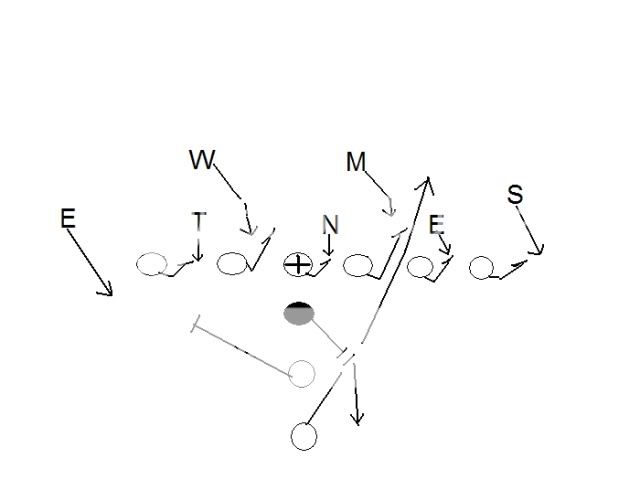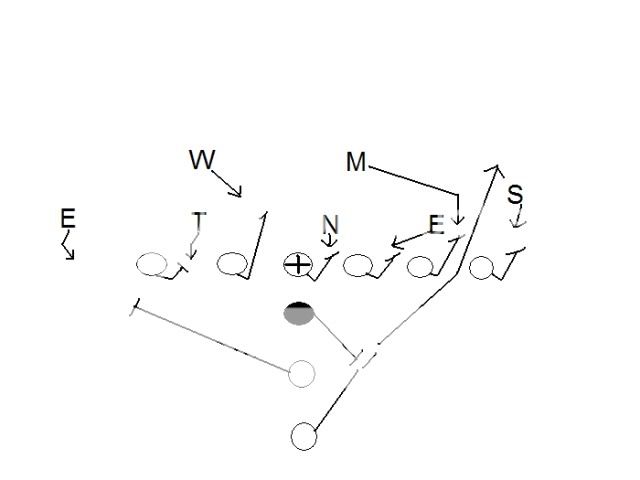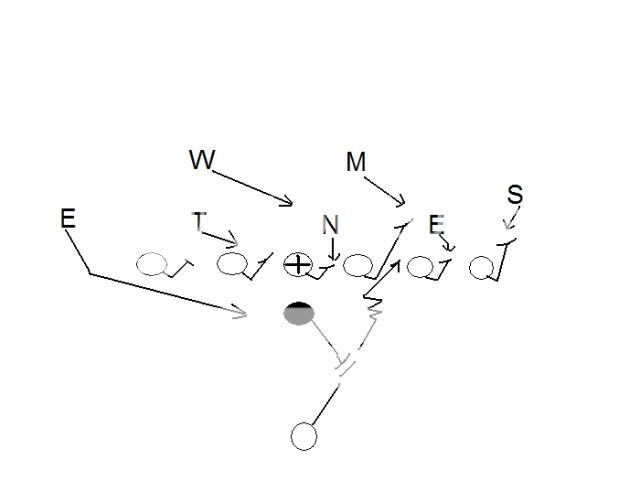- Joined
- Sep 11, 2007
- Messages
- 4,177
- Reaction score
- 1,854
With all of the bye week talk about Maroney and the 20 page circle jerks popping up everywhere, I thought it would be better to spin out a thread dedicated to actual analysis. I welcome thoughts and evaluation of the run game, but please bring evidence or detailed explaination. to the table As a general notice, if you have qualms, by all means speak your mind. If you are going to say a player sucks or call someone a doody head, this ain't your spot. If you have a case that needs to be made, then make it objectively and come correct.
I decided to think about some of the run game problems and have identified a few things. First, it is the damn zone scheme they keep banging their heads into walls trying to make effective. It just is not effective out of their primary sets. Second, it is the improper utilization of their linemen (which does tie in with the zone stuff). Third, and to be unorigional by stealing Unorgional's thunder; we need a fullback. A legit fullback. All of these combine to create the zone running as my version of other's Maroney.
First, let's take a long, hard look into what makes the zone blocking run. As the name says, it is predicated upon the lineman being able to block any player that occupies his zone. Directional runs were getting stuffed by stunting linemen and backers. The linemen couldn't find their assigned man, and accordingly coaches had to find a method to deal with this. By moving as a cohesive unit in a linear manner, the line simply could wash any flack, and the back would pick up a hole to accelerate through. This style of running does leave the backside of the play wide open, however, and the backside must have dedicated sealers in order to execute the scheme effectively. Let's take a look at some very basic examples of various zone running plays out of the I to give perspective on how it is intended to work.
Here is an example of Inside Zone at TE against standard 43 one gap run defense.

Here, it is as vanilla as it gets. Backside seal responsibilities lay with the fullback, each lineman run blocks, the back ID's the sealed mike as the intended hole, accelerates through.
To illustrate the concept behind the zone, here is the same play vs a basic end/mike stunt. If this defense was called against a standard man blocking scheme, the end would draw the tackle in, opening a lane for the mike to crash and blow up the play in the backfield.

In this case, the mike is blocked by the tackle, the end by the guard. This opens the area vacated by the crashing end and will in theory open a clean running lane for the back. Again, the fullback has backside seal responsibilities.
Now, let's look at the ace package the Patriots have been primarily running the inside zone at TE out of. This has been the bread and butter of the failed run plays and is the reason behind Maroney's "dancing".

Let's look at what is going on here. Without the fullback taking backside contain, and the team's tendency to run this play at the TE, the defense is free to scrape down the line immediately. The key to this defense is the crashing tackle getting in front of the face of the backside guard. The guard is assigned to pickup the will under normal zone, but he will pick up the crashing tackle as he moves across his face. The backside tackle is too slow to reach the will, and he becomes a free runner. Further, the end will already be in the backfield and coming hard towards the runner. Should the backside guard not seal the tackle, the tackle as well becomes disruptive. The nose will crash upfield, taking both the center and the playside a gap. The playside should be blocked normally, but instead of the mike and flowing will being blocked, only the mike is blocked. The flowing will should be already sealing the hole by the time the back reads the shoulder of the guard. At this point, the backside flow should be arriving in bad temper to finish the play. Any back who reads this playside block should see the two hole being the primary cut. With this two hole suddenly sealed by the flowing will, the back won't have anywhere to go. Should he try the bounce out, the SS should be sitting in the area off of the TE. Should he try to cut against the grain, the crashing end and possibly tackle will be there to finish him off. Hence, happy feet.
There's my amateur hour breakdown of what has been happening with the run blocking most of the time it fails. Another reason behind the failure is the mentality of the linemen. It's seal, seal, seal. There's nothing in the play that affords them the ability to go rock somone and drive them off of the football. It's a finesse run game, and linemen hate finesse running. Mankins and Neal both are exceptional screen blockers. People would lead one to believe that because of this, they fit well in zone schemes. In actuality, their true fit is the pull game. The screen is essentially a very wide multiple blockers pulling play. Let them pull and get back to the directional run game. This is the Rx for the run game in my opinion. What say ye?
I decided to think about some of the run game problems and have identified a few things. First, it is the damn zone scheme they keep banging their heads into walls trying to make effective. It just is not effective out of their primary sets. Second, it is the improper utilization of their linemen (which does tie in with the zone stuff). Third, and to be unorigional by stealing Unorgional's thunder; we need a fullback. A legit fullback. All of these combine to create the zone running as my version of other's Maroney.
First, let's take a long, hard look into what makes the zone blocking run. As the name says, it is predicated upon the lineman being able to block any player that occupies his zone. Directional runs were getting stuffed by stunting linemen and backers. The linemen couldn't find their assigned man, and accordingly coaches had to find a method to deal with this. By moving as a cohesive unit in a linear manner, the line simply could wash any flack, and the back would pick up a hole to accelerate through. This style of running does leave the backside of the play wide open, however, and the backside must have dedicated sealers in order to execute the scheme effectively. Let's take a look at some very basic examples of various zone running plays out of the I to give perspective on how it is intended to work.
Here is an example of Inside Zone at TE against standard 43 one gap run defense.

Here, it is as vanilla as it gets. Backside seal responsibilities lay with the fullback, each lineman run blocks, the back ID's the sealed mike as the intended hole, accelerates through.
To illustrate the concept behind the zone, here is the same play vs a basic end/mike stunt. If this defense was called against a standard man blocking scheme, the end would draw the tackle in, opening a lane for the mike to crash and blow up the play in the backfield.

In this case, the mike is blocked by the tackle, the end by the guard. This opens the area vacated by the crashing end and will in theory open a clean running lane for the back. Again, the fullback has backside seal responsibilities.
Now, let's look at the ace package the Patriots have been primarily running the inside zone at TE out of. This has been the bread and butter of the failed run plays and is the reason behind Maroney's "dancing".

Let's look at what is going on here. Without the fullback taking backside contain, and the team's tendency to run this play at the TE, the defense is free to scrape down the line immediately. The key to this defense is the crashing tackle getting in front of the face of the backside guard. The guard is assigned to pickup the will under normal zone, but he will pick up the crashing tackle as he moves across his face. The backside tackle is too slow to reach the will, and he becomes a free runner. Further, the end will already be in the backfield and coming hard towards the runner. Should the backside guard not seal the tackle, the tackle as well becomes disruptive. The nose will crash upfield, taking both the center and the playside a gap. The playside should be blocked normally, but instead of the mike and flowing will being blocked, only the mike is blocked. The flowing will should be already sealing the hole by the time the back reads the shoulder of the guard. At this point, the backside flow should be arriving in bad temper to finish the play. Any back who reads this playside block should see the two hole being the primary cut. With this two hole suddenly sealed by the flowing will, the back won't have anywhere to go. Should he try the bounce out, the SS should be sitting in the area off of the TE. Should he try to cut against the grain, the crashing end and possibly tackle will be there to finish him off. Hence, happy feet.
There's my amateur hour breakdown of what has been happening with the run blocking most of the time it fails. Another reason behind the failure is the mentality of the linemen. It's seal, seal, seal. There's nothing in the play that affords them the ability to go rock somone and drive them off of the football. It's a finesse run game, and linemen hate finesse running. Mankins and Neal both are exceptional screen blockers. People would lead one to believe that because of this, they fit well in zone schemes. In actuality, their true fit is the pull game. The screen is essentially a very wide multiple blockers pulling play. Let them pull and get back to the directional run game. This is the Rx for the run game in my opinion. What say ye?


















